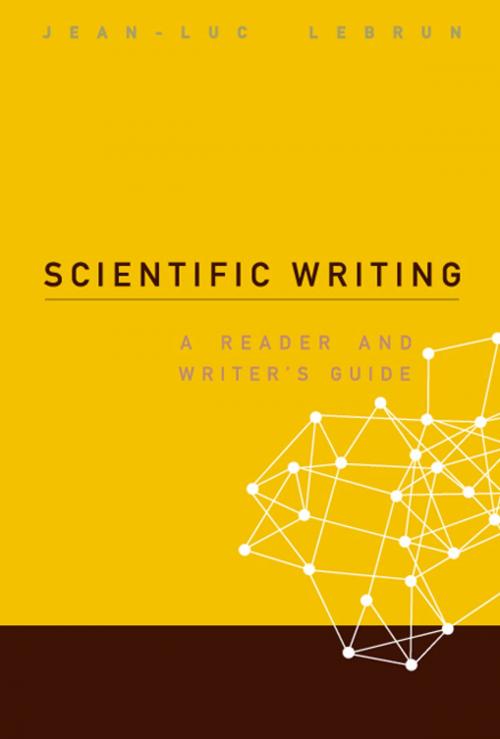Scientific Writing: A Reader and Writer's Guide
Kids, Natural World, Nonfiction, Reference & Language, Education & Teaching, Science & Nature, Science| Author: | Jean-Luc Lebrun | ISBN: | 9789814338233 |
| Publisher: | World Scientific Publishing Company | Publication: | April 5, 2007 |
| Imprint: | WSPC | Language: | English |
| Author: | Jean-Luc Lebrun |
| ISBN: | 9789814338233 |
| Publisher: | World Scientific Publishing Company |
| Publication: | April 5, 2007 |
| Imprint: | WSPC |
| Language: | English |
Check out the author's website at www.scientific-writing.com
Given that scientific material can be hard to comprehend, sustained attention and memory retention become major reader challenges. Scientific writers must not only present their science, but also work hard to generate and sustain the interest of readers. Attention-getters, sentence progression, expectation-setting, and “memory offloaders” are essential devices to keep readers and reviewers engaged. The writer needs to have a clear understanding of the role played by each part of a paper, from its eye-catching title to its eye-opening conclusion. This book walks through the main parts of a paper; that is, those parts which create the critical first impression.
The unique approach in this book is its focus on the reader rather than the writer. Senior scientists who supervise staff and postgraduates can use the book to review drafts and to help with the writing as well as the science. Young researchers can find solid guidelines that reduce the confusion all new writers face. Published scientists can finally move from what feels right to what is right, identifying mistakes they thought were acceptable, and fully appreciating their responsibility: to guide the reader along carefully laid-out reading tracks.
Contents:
-
The Reading Toolkit:
- Require Less from Memory
- Sustain Attention to Ensure Continuous Reading
- Reduce Reading Time
- Keep the Reader Motivated
- Bridge the Knowledge Gap
- Set the Reader's Expectations
- Set Progression Tracks for Fluid Reading
- Create Reading Momentum
- Control Reading Energy Consumption
-
Paper Structure and Purpose:
- Title: The Face of Your Paper
- Abstract: The Heart of Your Paper
- Headings/Subheadings: The Skeleton of Your Paper
- Introduction: The Hands of Your Paper
- Introduction Part II: Popular Traps
- Visuals: The Voice of Your Paper
- Conclusion: The Smile of Your Paper
Readership: All scientists for whom the “publish or perish” saying applies, whether in academia or in companies engaged in research activities, and postgraduates writing dissertations or theses.
Key Features:
- Reader-centered writing: A systematic look at the causes of reader frustrations; a thorough description of the roles of the main parts of a paper for the reader
- Story- and example-based narratives justifying each guideline; no grammarian dictate: Reasonable departures from more literary writing practices to satisfy the needs of scientific readers; easy to read, even for non-native English writers
- Practical: Immediately useful advice on how to review the draft of a paper in each chapter; easy-to-use tools and qualitative evaluation criteria
Check out the author's website at www.scientific-writing.com
Given that scientific material can be hard to comprehend, sustained attention and memory retention become major reader challenges. Scientific writers must not only present their science, but also work hard to generate and sustain the interest of readers. Attention-getters, sentence progression, expectation-setting, and “memory offloaders” are essential devices to keep readers and reviewers engaged. The writer needs to have a clear understanding of the role played by each part of a paper, from its eye-catching title to its eye-opening conclusion. This book walks through the main parts of a paper; that is, those parts which create the critical first impression.
The unique approach in this book is its focus on the reader rather than the writer. Senior scientists who supervise staff and postgraduates can use the book to review drafts and to help with the writing as well as the science. Young researchers can find solid guidelines that reduce the confusion all new writers face. Published scientists can finally move from what feels right to what is right, identifying mistakes they thought were acceptable, and fully appreciating their responsibility: to guide the reader along carefully laid-out reading tracks.
Contents:
-
The Reading Toolkit:
- Require Less from Memory
- Sustain Attention to Ensure Continuous Reading
- Reduce Reading Time
- Keep the Reader Motivated
- Bridge the Knowledge Gap
- Set the Reader's Expectations
- Set Progression Tracks for Fluid Reading
- Create Reading Momentum
- Control Reading Energy Consumption
-
Paper Structure and Purpose:
- Title: The Face of Your Paper
- Abstract: The Heart of Your Paper
- Headings/Subheadings: The Skeleton of Your Paper
- Introduction: The Hands of Your Paper
- Introduction Part II: Popular Traps
- Visuals: The Voice of Your Paper
- Conclusion: The Smile of Your Paper
Readership: All scientists for whom the “publish or perish” saying applies, whether in academia or in companies engaged in research activities, and postgraduates writing dissertations or theses.
Key Features:
- Reader-centered writing: A systematic look at the causes of reader frustrations; a thorough description of the roles of the main parts of a paper for the reader
- Story- and example-based narratives justifying each guideline; no grammarian dictate: Reasonable departures from more literary writing practices to satisfy the needs of scientific readers; easy to read, even for non-native English writers
- Practical: Immediately useful advice on how to review the draft of a paper in each chapter; easy-to-use tools and qualitative evaluation criteria















